![]()
![]()
![]()
Use LEFT and RIGHT arrow keys to navigate between flashcards;
Use UP and DOWN arrow keys to flip the card;
H to show hint;
A reads text to speech;
20 Cards in this Set
- Front
- Back
- 3rd side (hint)
|
About 800-900 BCE
|

Goat ate berry, the Goat herder (kaldi) noticed the goat was energetic and tried one himself. Later, a monk came across the energetic goat herder, picked some berries and crushed them to powder and added them to boiling water. Shared with fellow findings and considered it a "gift from the lords" to help them stay up during long prayers.
|
Goat, kaldi, and monk
|
|
|
About 1000 BC
|
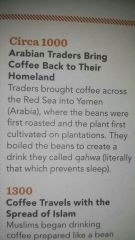
Arabian traders bring coffee across red sea to Yemen. Beans roasted and cultivated on plantations. Beans boiled to create "qahwa" (that which prevents sleep)
|
Arabian traders, rusted beans, qahwa
|
|
|
1300 BC
|
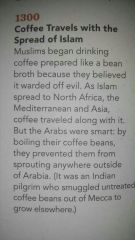
Muslims drink it like bean broth to ward off evil. Islam spread to N. America, coffee traveled with it. However Arabs boiled the beans, so therefore they could not sprout any more. Only grew in Arabia.
|
Muslims, boiled beans
|
|
|
1450-1650BC
|
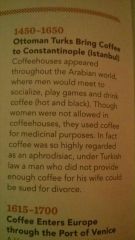
Coffeehouses appeared all through Arabia. Men socialized, played games, and drank coffee. No women allowed. However it was used as an aphrodisiac, and if a man didn't give his wife enough coffee, could be sued for divorce
|
Coffee house, no women, aphrodisiac, divorce
|
|
|
1615-1700bc
|

Coffee enters Europe. A venetian merchant feel in love with coffee in Turkey and brought it to Europe and sold it in Italy. Coffeehouses then opened in Italy (1645-1655) London (1652) and Paris (1672)
|
|
|
|
1690
|
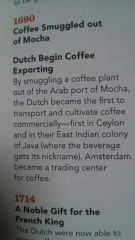
Dutch smuggled a coffee plant out if Arab port of mocha and because the first to transport it commercially, first in Ceylon, then Indian colony of Java (like the nick name) and Amsterdam became a trading center for coffee
|
Dutch, Java, Amsterdam
|
|
|
1714
|
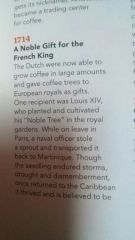
Dutch grew large amounts of coffee and gave to European royals as gifts, like Louis XIV (14?) who planted and cultivated his tree in the royal garden. A navel soldier stole a sprout, and despite storms, drought, avid dismemberment, it thrived when it got to the carribean, and is thought to be the father of most arabica trees alive today in French and central/Latin America.
|
Louis XIV, sprout survived, father of arabica
|
|
|
1727
|
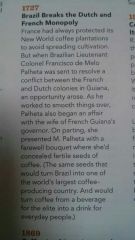
The French were protective of their coffee to avoid spreading cultivation. Brazilian lieutenant Colonel Francisco DE Melo palheta sent to resolve conflict. He begin an affair with the wife of French guianas governor. When he left she gave him a bouquet with fertile coffee seeds hidden. This seed turned Brazil intuitive largest coffee producing country, allowing coffee to be consumed by every day people.
|
Fance, Brazil, affair, bouquet, fertile seed
|
|
|
1869
|
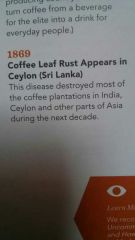
Coffee leaf rust appears in sir Lanka, Ceylon. Destroyed most plantations in India, Ceylon, and other parts of Asia.
|
Disease, sir Lanka
|
|
|
1882
|
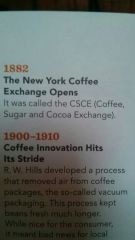
New York coffee exchange opens, known as the CSCE (Coffee Sugar, and Cocoa Exchange)
|
Csce
|
|
|
1900-1910
|

R. W. hills developed vacuum sealed coffee packages for keeping beans fresh longer. This was good for costumers, but many local roasters had to close shop.
Lugi Bezzera invents first commercial espresso machine. Rumor is he wanted his workers to have shorter coffee breaks, so he created a machine that sped up brewing process (espresso or express coffee) |
R. W. Hills vacuum, luigi Bezzera, espresso machine, short coffee breaks
|
|
|
1900
|

Legend has it that Ludwig Roselius and Karl Wimmer, German coffee importers, accidently figured out how to make decaf coffee in 1903. One of their shipments from Nicaragua was soaked in seawater. While the taste was still good, the beans had lost most of their caffeine, and researchers then figured out how to extract caffeine solvents and steam.
|
Germans, seawater
|
|
|
1901
|

Japanese American chemist Satori Kato created a soluble blend of coffee. In 1906 inventor George Washington took this concept and premiered the first mass produced instant coffee, unfortunately with little flavor
|
Satori Kato,George Washington
|
|
|
1908
|

Melitta Benz wanted to brew the ideal cup if coffee with out the bitterness from over brewing. After trial and error she found that her sons school blotting I paper was the right tool. She cut it into a circle, placed it in a metal cup with holes poked in the bottom, and pores hot water in it and kept the grounds from the cup.
|
Melitta Benz, sons blotting paper
|
|
|
1933
|
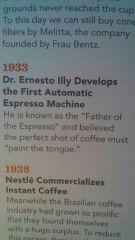
Dr. Ernest Illy develops first automatic espresso machine, aka the father of espresso, and believed the perfect shot of coffee should paint the tongue
|
|
|
|
1938
|

Brazilian coffee industry has grown so prolific that they had a huge surplus. To reduce surplus, they need an easier way to drink it so more people would. Swiss company Nestlé helped with that by inventing a coffee that dissolves in water with out losing flavor. It took Max Morgenthaler 7 years to perfect the freeze dried coffee, and create Nestlé. It was such a hit with the armed forces that it was exclusive for military use for WWII. Sales were boated in 56 with the introduction of commercial breaks on US TV. While not enough time to brew tea, the breaks were just long enough to make instant coffee. The tea company, not to lose the edge, soon created tea bags.
|
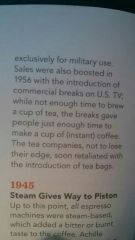
|
|
|
1945
|

Up to this point all espresso machines were steamed based, which added a bitter or burnt taste to the coffee. Achille Gaggia spent years developing a machine that abandoned steam and used piston pumps and water to extract the brew at a higher pressure. His machine was a success, and his new machine added an unexpected discovery; for the first time "crema" appeared on a shot of espresso- the beautiful light colored foam that's an essential part of espresso shots today.
|
Piston espresso,achillie, crema
|
|
|
1948
|

Cappuccino means 'little hood' and got that name for 2 reasons. Both the coffees brown color and the pointy cap of foam placed a top the drink reminded Italians of capuchins, the brown robed hooded order of monks seem walking amid the people
|
Little hood, capuchins
|
|
|
1966
|
Alfred peet, son of a Dutch coffee roaster, born in Holland, traveled the world working as a coffee taster and buyer. His career finally took him to USA, where he found that the coffee sucked. He started roasting his own and soon opened peets coffee and tea in Berkeley. He developed an appetite for dark roasted coffee drinkers who thirsted for more flavor than was found in the week coffee of the day. He mentored jerry Baldwin, zev siegl and Gordon Bowker in his rosting style. These three young men would become the founders of Starbucks
|
Alfred peet, coffee taster, USA coffee sucked, dark roast, Jerry Baldwin zev siegl and Gordon bowker
|
|
|
1971
|
Starbucks opens first store in Seattles pike place market. It started in brain storming session that referenced the first mate (Starbuck) in Melvilles moby dick, the name evoked the romance of the high sea and the sea fearing tradition of early coffee traders.
|
Pike place, moby dick, first mate
|

